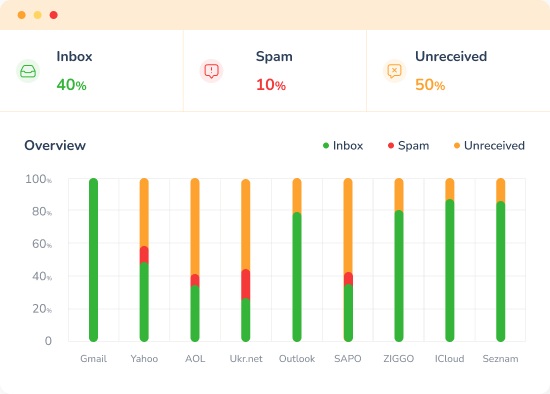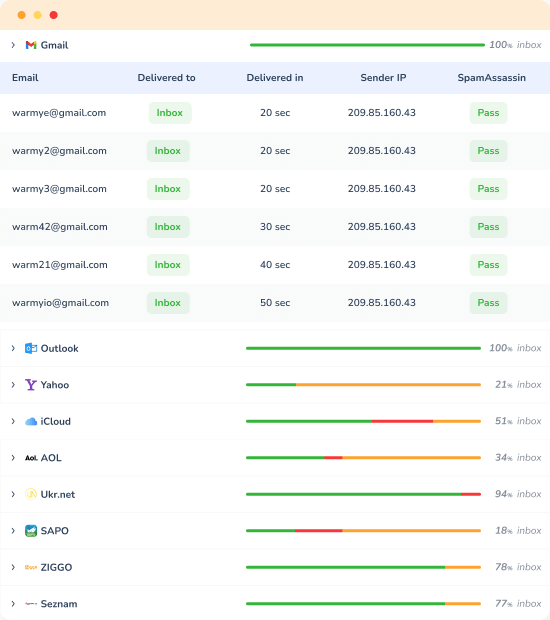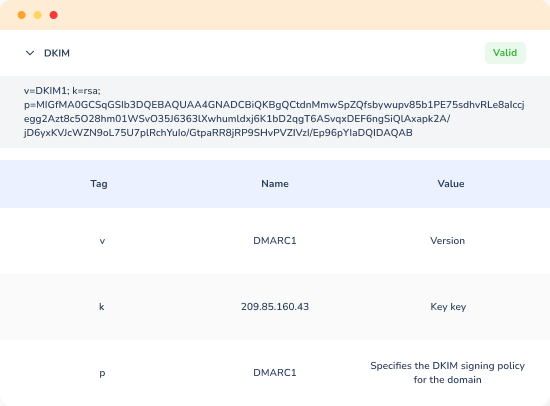Hello readers! Today, I’m excited to guide you through the process of using our free email deliverability test tool. This tool is an invaluable resource for anyone looking to ensure their emails reach their intended recipients without any hitches. So, without further ado, let’s dive in!
What is inbox placement test?
An Inbox Placement Test is a diagnostic tool used by email marketers and businesses to determine where their emails land in recipients’ mailboxes: in the main inbox, a subfolder, the spam folder, or if they don’t get delivered at all. This test provides insights into the deliverability of emails, helping senders understand and optimize their email campaigns.
The importance of email deliverability and inbox placement test
Before we dive into the step-by-step guide, let’s understand the significance of these tests:
✅ Email Deliverability Test
This test ensures that your emails are successfully delivered to the recipient’s server. A failed deliverability test could mean that your emails are being blocked or rejected by the server, which could be due to various reasons like being blacklisted or having a poor sender reputation.
✅ Inbox Placement Test
While deliverability ensures your email reaches the server, inbox placement ensures it lands in the recipient’s inbox and not the spam or junk folder. A successful inbox placement test means your email content, sender reputation, and other factors align well with the recipient’s email service provider’s algorithms.
Both tests are crucial for anyone serious about their email campaigns. Without them, you’re essentially shooting in the dark, hoping your emails reach their destination and achieve their intended purpose.
Step-by-step guide: How to use the inbox placement test from Warmy.io
1. Accessing the Tool:
– Start by visiting the main page of warmy.io
– Navigate to the ‘free tools’ bar.
– Click on ’email deliverability test’.
2. Initiating the Test:
– Once you’re on the page, you’ll see a list of emails you’re set to send.
– Depending on your email client, you can select the desired format for address separation from the dropdown menu. Options include line breaks, line breaks with commas, and more.
– Click the ‘Copy’ button to copy these email addresses.
3. Composing the Email:
– Head over to your mailbox and create a new email.
– In the ‘To’ section, paste the copied email addresses.
– Craft a compelling subject line and message for your prospects.
4. Executing the Test:
– After sending the email, return to the warmy.io website.
– Click on the ‘check email deliverability’ button.
– A green bar will appear, indicating the test’s progress. It’s recommended to wait until the test completes, although preliminary results might be available.
5. Understanding the Results:
The results will show various metrics, including:
1. Number of emails that landed in the inbox.

2. Number of emails that went to spam.
3. Emails that weren’t delivered for various reasons.
4. You’ll also see deliverability percentages for each email provider.

Clicking on a provider will give a detailed analysis, including:
◾ The checker’s email address and its landing spot (inbox or spam).
◾ Delivery time and sender IP.
❗ Note: Some providers like Gmail or Outlook use shared servers, so multiple IP addresses are normal. However, if your email server is static with a specific IP, pay close attention.
5. Scroll further to check if your domain is blacklisted

❗ Do not panic if you see any of the marked blacklists, maybe you just use a shared server (Gmail or Outlook for example), or your domain is very young. In this case, you may be Listed for a while.
6. Sender Authentication. Here you can see what your DNS records look like, such as SPF, DKIM, and DMARC. If records are missing, we strongly recommend adding them in your domain control panel.

6. Sharing and Next Steps:
– If you’re proud of your results or want feedback, there’s an option to share them on social media.
– For those keen on enhancing their email deliverability, consider signing up with warmy.io for more advanced features and guidance.
Conclusion
In conclusion, email deliverability is crucial in today’s digital age. Ensuring your emails reach their intended destination can make a significant difference in your communication efforts. So, give our tool a try, and here’s wishing you the best of luck with your testing! If you’re looking to further improve your email deliverability, warming.io is here to assist.
FAQ
How often should I conduct an inbox placement test?
Inbox placement tests are crucial to ensure that your emails are reaching your recipients' inboxes and not being flagged as spam or junk.
It's recommended to conduct an inbox placement test:
- Before launching a significant email campaign.
- Whenever you make significant changes to your email content or design.
- At regular intervals, such as quarterly, to ensure consistent deliverability.
Why are my emails landing in the spam folder even after passing the spam test?
Even if your emails pass spam tests, several factors can cause them to land in the spam folder:
- Sender Reputation: If your sending IP or domain has a poor reputation, ISPs might flag your emails as spam.
- Engagement Rates: Low open and click-through rates can signal to ISPs that recipients are not interested in your emails.
- Complaint Rates: If a high number of recipients mark your emails as spam, ISPs will take note.
- Authentication Issues: Ensure that you have set up SPF, DKIM, and DMARC correctly.
- Content and Design: Certain words, phrases, or design elements can trigger spam filters.
Can I improve deliverability rates overnight?
Improving email deliverability rates is a process and often can't be achieved overnight. However, some immediate actions can help:
- Ensure your email lists are clean and free from invalid or outdated addresses.
- Segment your audience and send relevant content.
- Avoid spammy words or phrases in your content.
- Ensure proper email authentication with SPF, DKIM, and DMARC.
- Monitor feedback loops and address any complaints promptly.
Remember, building a good sender reputation takes time and consistent effort.
Are there any legal implications for emails marked as spam?
Yes, there are legal implications for sending unsolicited emails or emails that are frequently marked as spam. Laws like the CAN-SPAM Act in the U.S., GDPR in Europe, and CASL in Canada set strict guidelines for commercial emails.











